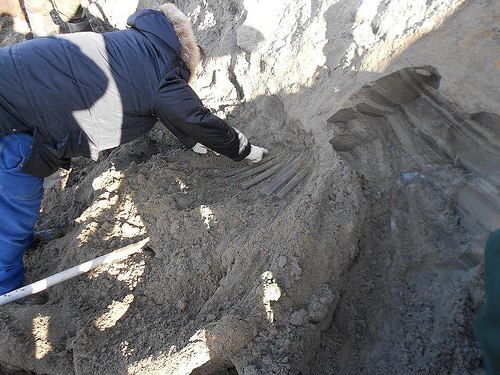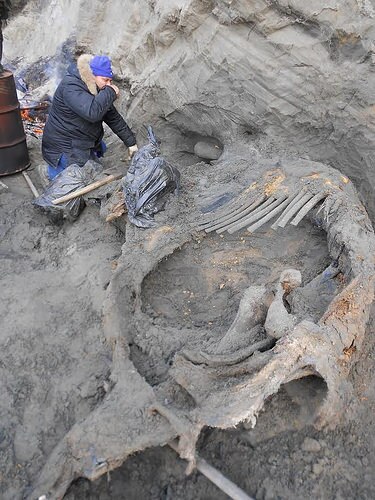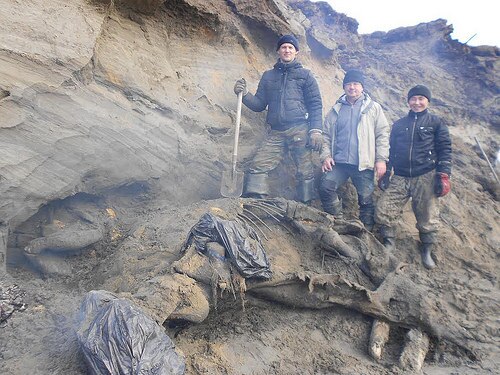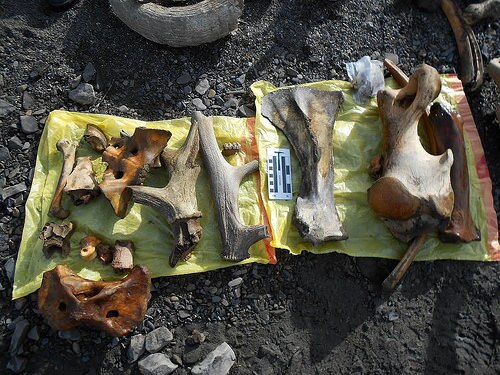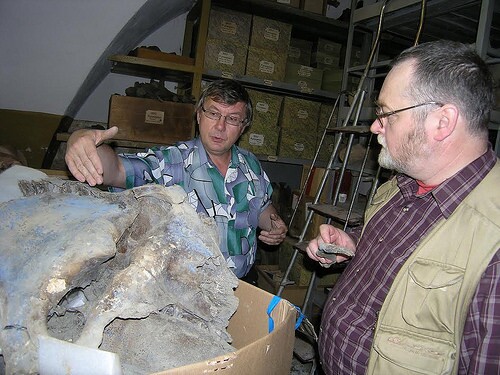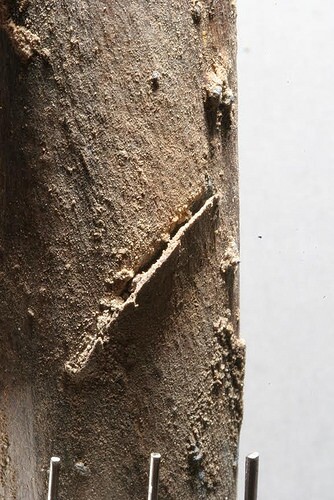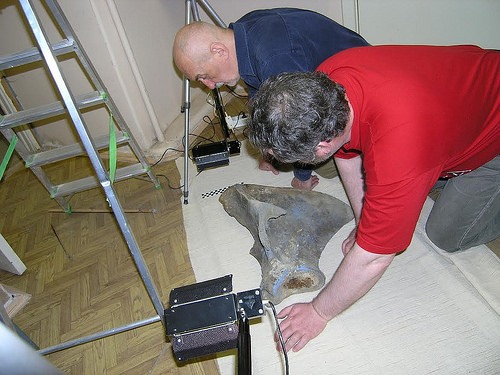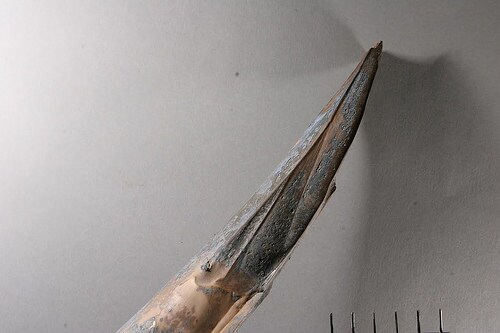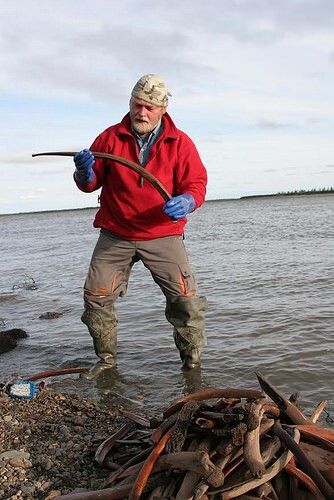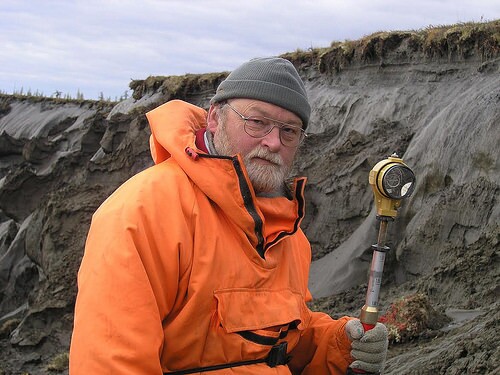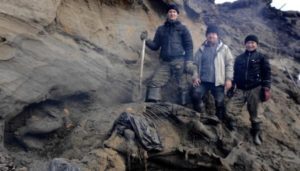
For some, July and August in Siberia’s otherwise frigid Taimyr Peninsula could afford tolerable temperatures for walking about. At least that was the case for 11-year-old young explorer Yevgeny Salinder. During the summer of 2012, Yevgeny was living with his parents at the Sopkarga polar meteorological station on the Sopochnaya Karga (SK) Cape, where they were working. About 2,200 miles northeast of Moscow, the Cape is a stark sub-polar alpine landscape with mossy bogs, a moist tundra with waterlogged soils, and a home for the likes of animals like reindeer, wolves, arctic foxes, wolverines and mountain hare. For most of humanity, exploring this area might be at once both severe and exotic. For Yevgeny, however, a day’s adventure hiking about the Cape would not have been extraordinary.
Until he found a dead mammoth along the way.
Preserved for tens of thousands of years where it fell to its death in the permafrost, at least some of its remains were exposed enough by 2012 to have been visible to young Yevgeny on a coastal bluff off the eastern shore of Yenisei Bay—limbs sticking out of the frozen mud where a river enters the Yenisei Bay just 3 kilometers away from his station home.
It was like finding buried treasure.
After his return, he told his parents who, recognizing the potential rarity and import of the discovery, brought it to the attention of those who would know something about such things—like Alexei Tikhonov of the Russian Academy of Sciences in St. Petersburg. Tikhonov is a zoologist by education, but he is perhaps best known for his recent discoveries and published research related to paleontological finds through various excavations at arctic and subarctic locations. Leading a small team in late September of 2012, Tikhonov carefully excavated the carcass from its natural grave. In the process, more of its features became apparent—a nearly complete mammoth, with the right half of the carcass still retaining soft tissue, including skin, hair, one ear and even male reproductive organs. Weighing in at more than 500 kg, it turned out to be among the best-preserved mammoths ever found. The excavated remains were sent for cold storage in nearby Dudinks and then shipped to St Petersburg in early May of 2013.
A Pleistocene Hunting Scene
The most tantalizing findings, however, did not occur until after the scientists dated the bones and began examining them up close. Now popularly nick-named ‘Zhenya’ after the boy founder, researchers determined that the SK mammoth was about 15 or 16 years old when he died at least 45,000 years ago, based on radiocarbon dating. The likely cause of death—human hunting.
This was revelatory, as up until now no humans were known to have existed in the Arctic this long ago. “The [new Yenisei Bay] site is much older than everything known before in the arctic regions, and it is clearly located farther north from the areas where sites of that age have been found,” said Vladimir Pitulko, also of the Russian Academy of Sciences, who examined the remains in detail. “It is about 20 degrees north (about 1900 km, or 1300 miles) of any site of comparable age…… and this is a big change.”
So how did Pitulko and his colleagues come to suggest that Zhenya met his fate by human hunters?
After closely examining Zhenya’s bones, including the left scapula, several ribs, jugal bone, and right tusk, Pitulko could come to no other conclusion than that they bore marks characteristic of wounds inflicted by a weapon and butchering marks left by stone tools. He knew this because at least one of the marks exhibited features very similar to those he found on a Pleistocene wolf humerus from excavations he conducted at Bunge-Toll in the middle Yana river in the western part of the Yana-Indighirka lowland (in westernmost Western Beringia), years before. The wolf remains had been found among the remains of other Pleistocene megafauna, such as mammoth, bison, reindeer, and rhinoceros. Using high-resolution X-ray computed tomography done by Konstantin Kuper at the Budker Institute for Nuclear Physics in Novosibirsk, Pitulko and colleagues could see a clear bone injury caused by penetration of a sharp implement with a conical tip. “The tool penetrated the bone deeply, taking pieces of cortical pieces inside the bone, which means it was a powerful blow,” said Pitulko. And now, some years later, Zhenya’s bone marks were likewise telling. “One of them was found on the inner side of the jugal bone (cheek bone) which was still attached to the skull. There is no natural or taphonomic reason for such an injury — this was not a bone pathology, it was not the result of carnivore chewing and it was not left by the excavation process — therefore we may expect it to be a result of human contact,” said Pitulko. After X-ray computer tomography conducted by Konstantin Kuper, the researchers were actually able to determine the inflicting weapon’s shape and size, enough to even reconstruct the shape of the tip that penetrated the bone. “It had a thinned symmetric outline and was relatively sharp,” continued Pitulko. “In most cases, bone or ivory weapons have a conical tip that is symmetric and quite acute (~30° to 40°) at the end, but they are [usually] relatively fragile and often break as they penetrate bones. In this case, the tool resisted breaking and inflicted injury on the cranial bones. The blade retained its weapon characteristics and retained enough energy to penetrate the cheekbone surface deeply into the bone. The blow was evidently very powerful and was suffered by the animal from the left back and from top down, which is only possible if the animal was lying down on the ground.” Pitulko suggests that the blow was likely an attempt intended for the base of Zhenya’s trunk, a hunting practice still used by elephant hunters today to cut major arteries and cause mortal bleeding. “This blow becomes necessary,” he maintains, “after the animal has been sufficiently injured, and the SK mammoth (Zhenya) displays numerous injuries in the thoracic area (the ribs and the left scapula). The most remarkable of them is found on the fifth left rib. This is an incision or cut mark left by some sharp tool slicing down. This pattern is very typical on mammoth bones, specifically on ribs, found [for example] at the Yana site.”
Overall, Tikhonov, Pitulko and colleagues suggest a scene where Zhenya was encountered by human hunters about 45,000 years ago, wounded/ brought down and killed, and then butchered immediately thereafter in place. Cut marks clearly made by cutting tools were evidenced on the left scapula and ribs, and even the right tusk showed signs of bone removal of a nature that suggested the possibility that the hunters fashioned ivory cutting tools from Zhenya himself.
________________________________________________
Excavations of the SK mammoth site in late September of 2012 near Sopochnaya Karga weather station at the Yenisei river mouth. Photo by Aleksei Tikhonov
______________________________________________________________
SK mammoth (‘Zhenya’) unearthed. Sergey Gorbunov is excavating the left side of the carcass in the head area. Photo by Aleksei Tikhonov
____________________________________________________________
The SK mammoth (‘Zhenya’). Aleksei Tikhonov (in the middle, and his field crew). Photo by S.V.Gorbunov
_______________________________________________
Selection of bones collected by Tikhonov at the Bunge-Toll site. Note the wolf humerus (top left) positioned by the injuried side up. Photo Aleksei Tikhonov
___________________________________________________
Aleksei Tikhonov (left) and Vladimir Pitulko discussing injury on the jugal bone of the SK mammoth at Zoological Museum (RAS), St Petersburg. Photo by Elena Pavlova
______________________________________________________
Cut mark on the SK mammoth 5th left rib. Photo Pavel Ivanov
_____________________________________________________
Documenting human caused injuries on the SK mammoth scapula at the Institute for the History of Material Culture, RAS, St Petersburg. Pavel Ivanov and Vladimir Pitulko (on the right). Photo by Elena Pavlova
_________________________________________________________
The Significance and Implications
Paleolithic records of humans in the Eurasian Arctic are relatively scarce. Only a few sites in this region have yielded clues to an early human presence. In mainland arctic Siberia, the site of Berelekh, discovered by Nikolay Vereschagin in the early 70s, was for years the location yielding the oldest evidence for human migration into the arctic regions. It dated to about 13,000 years ago. But in 2001 another site in Siberia, known as Yana, produced evidence of a human presence dating back to about 27,000 -30,000 years. Excavated by archaeologist Vladimir Pitulko, also of the Russian Academy of Sciences, it yielded tools made from rhinoceros horn and mammoth tusk, as well as hundreds of other stone artifacts including choppers, scrapers and other biface implements. “But I never thought that even this was the final age estimate for human migrations into the arctic,” said Pitulko.
So Zhenya and the SK site have buttressed the site researchers’ suggestion that people were present in the central Siberian Arctic by about 45,000 years ago. At this time, according to Pitulko, mammoth hunting by modern humans probably became a critical element in human survival in the harsh environment and landscape of what is today Siberia. Like the modern-day elephant, the mammoth would have provided a critical source of food, fuel (dung, fat, and bones), and raw material for construction and hunting weapons and tools for processing, all the more important in the open landscapes of the Northern Eurasian steppe, which is mostly tree-less. Removed from the hunted dead carcasses of their mammoth prey, “ivory became a substitution for materials used for shafts and points long and strong enough for killing large animals, not necessarily the mammoth,” said Pitulko. “Such tools are found elsewhere in the Upper Paleolithic, and this includes even full-size spears of ivory which are known from [the sites of] Sunghir, European Russia or from Berelekh, Siberia. This innovation became a really important discovery for humans and finally helped them in surviving and settling these landscapes.”
_______________________________________________
Worked tip of the SK mammoth tusk. Photo by Pavel Ivanov
_________________________________________________
Field study of the bones collected at the Yana site from the Yana mass accumulation of mammoth (August 2012) – looking for human impact. Photo Elena Pavlova
___________________________________________________________________
Pitulko surveying exposures in Yana river. Photo Elena Pavlova
____________________________________________________________________
Thus, according to the researchers’ report, advancements in mammoth hunting likely allowed humans to survive and spread widely across northernmost Arctic Siberia at this time, representing an important cultural shift – one that likely facilitated the arrival of humans in the area close to the Bering land bridge, providing them an opportunity to enter the New World before the Last Glacial Maximum.
“This is especially important for questions related to the peopling of the New World, because now we know that the eastern Siberia up to its arctic limits was populated starting at roughly 50,000 years ago,” says Pitulko. “Until 15,000 years ago, sea-level (though changing) still remained low, which is clear from appropriate dates on terrestrial animals in the New Siberian islands. This presumes that the Bering Land Bridge existed probably most or part of this time, so the New World gate remained open…….The history of the territory which we call Western Beringia is of particular interest since it is close to the Bering Land Bridge area and then everything that was going on in this area is related (or can be related) to the question of the peopling of the New World. Most of the Eurasian north, including Western Beringia, was unglaciated [at this time] and available for humans.”
Could modern humans have crossed over to the New World from here in these early times?
“Probably yes,” says Pitulko.
But did they?
Pitulko recognizes that there is much more work to do, and additional finds that need to be made, before this question can be answered and a conclusive picture of human habitation in these regions can be drawn. In any case, for now, a new stage is set for going forward.
“These finds change our minds about possible options and this is going to provide a new stimulus for further research.”
______________________________________________________________

